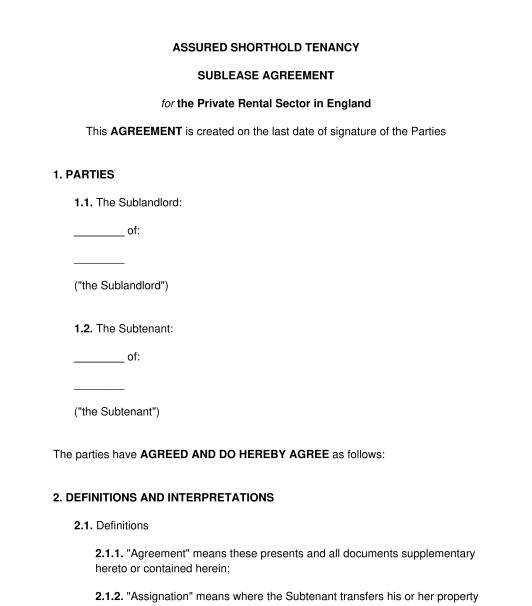 27/09/2025
27/09/2025

Answer a few questions and your document is created automatically.

Your document is ready! You will receive it in Word and PDF formats. You will be able to modify it.

 27/09/2025
27/09/2025
 Word and PDF
Word and PDF
 12 to 19 pages
12 to 19 pages



A tenant who is already renting a private residential property can use a sublease to grant a tenancy to another tenant. The new tenant becomes a subtenant, and the existing tenant will be the sublandlord.
The property will be used as a subtenant's home and main place of residence. This sublease can be used in England*.
A different sublease agreement is available for use in Scotland.
A sublease is different from a lodger agreement. A subtenant will have particular rights as a tenant under a sublease (including protection from unfair eviction). A subtenant will enjoy exclusive occupation of the relevant property, whereas a lodger will only have the right to use a certain space or room and the landlord will retain the right to occupy that space at all times.
The formal legal term for a lodger agreement is a 'licence to occupy'. A licence is an agreement that permits a person to do something. A licence to occupy (a lodger agreement) therefore, permits a person to occupy a space or part of a property but does not grant a legal interest in the property.
A residential sublease will be used where the subtenant will live in the property and the property will be used as their home.
A commercial sublease will be used where the property will be occupied for business purposes only. Commercial subtenants have distinct and different rights and responsibilities (for example the requirement to undertake a health and safety risk assessment in relation to the property).
A guarantor will agree to pay the rent in the event that the subtenant cannot or does not pay this. It is possible for the guarantor to be in an individual or a corporate entity (a company). This sublease may include a guarantor as a party if desired.
A sublease should not include any clause which demands the payment of a deposit that is above the legal limits. A deposit must not exceed five weeks' rent - unless annual rent is £50,000 or more (in which case the limit is six weeks' rent).
Before the sublandlord grants the sublease, they should:
A sublandlord may also request to undertake additional checks about:
The sublandlord should ensure that they have permission to let the property from their landlord.
The subtenant must have the right to rent a property in the United Kingdom. This means that their immigration documents must be checked
Both of the parties should be over the age of 18 and have capacity. Capacity refers to a person's ability to make and understand decisions.
The parties can agree upon a fixed term. Commonly, this will be a period of 6 or 12 months. After the fixed term, the sublease will usually convert into a periodic (rolling) tenancy.
This sublease is designed for use where the fixed term will not exceed 3 years. If the parties wish to create a sublease for a term exceeding 3 years, then there will be additional requirements and formalities.
If the parties would like to seek any about a sublease for a term exceeding 3 years, they should seek specialist advice from a regulated lawyer.
The parties should sign and date the agreement once it has been finalised. After the document has been signed, the parties should retain a version that contains the signature of each party. The subtenant may then occupy the property under the terms of the agreement.
The agreement must include an inventory and schedule of condition should be completed and attached to the agreement before signing. A property inventory and schedule of condition will provide a summary of all the items (such as furniture and white goods) in the property and will note the condition of those items.
The sublandlord should also provide the subtenant with a copy of the master lease (the tenancy agreement held between the sublandlord and their own landlord).
A subtenant can end a sublease:
A sublandlord can end a sublease:
A sublandlord should seek advice and/or obtain information about the termination process, required notice periods and the relevant legal grounds before ending a tenancy.
A sublease should include information about:
The following legal provisions are most relevant to a sublease:
A sublandlord should also consider safety/legal requirements relating to:
You fill out a form. The document is created before your eyes as you respond to the questions.
At the end, you receive it in Word and PDF formats. You can modify it and reuse it.
Guides to help you
Residential Sublease (England and Wales) - Template
Country: United Kingdom